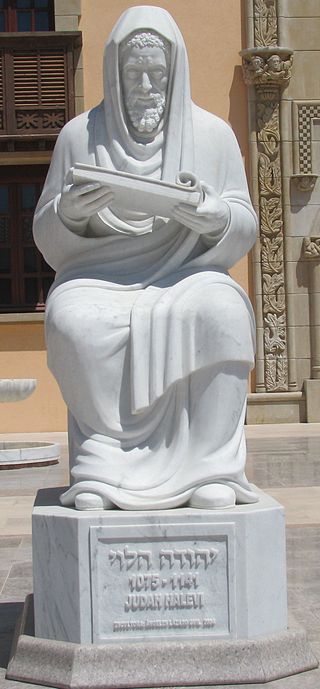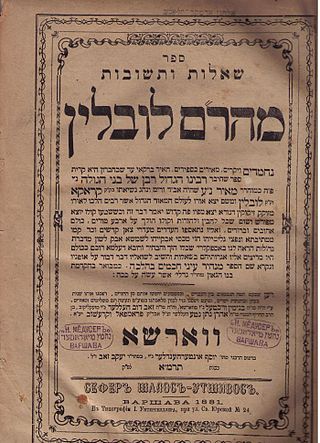Related Research Articles

Judah ha-Nasi or Judah I, known simply as Rebbi or Rabbi, was a second-century rabbi and chief redactor and editor of the Mishnah. He lived from approximately 135 to 217 CE. He was a key leader of the Jewish community in Roman-occupied Judea after the Bar Kokhba revolt.

The Tosefta is a compilation of Jewish Oral Law from the late second century, the period of the Mishnah and the Jewish sages known as the Tannaim.
Gershom ben Judah, best known as Rabbeinu Gershom and also commonly known to scholars of Rabbinic Judaism by the title Rabbeinu Gershom Me'Or Hagolah, was a famous Talmudist and Halakhist.

Abraham ben Meir Ibn Ezra was one of the most distinguished Jewish biblical commentators and philosophers of the Middle Ages. He was born in Tudela, Taifa of Zaragoza.

Judah Halevi was a Sephardic Jewish poet, physician and philosopher. He was born in Al-Andalus, either in Toledo or Tudela, in 1075. He is thought to have died in 1141, in either Jerusalem, at that point the Crusader Kingdom of Jerusalem, or in Alexandria, Egypt.
Tannaim were the rabbinic sages whose views are recorded in the Mishnah, from approximately 10–220 CE. The period of the Tannaim, also referred to as the Mishnaic period, lasted about 210 years. It came after the period of the Zugot "Pairs" and was immediately followed by the period of the Amoraim "Interpreters".

Jewish writers in England during the pre-expulsion period of the eleventh through the thirteenth centuries produced different kinds of writing in Hebrew. Many were Tosafists; others wrote legal material, and some wrote liturgical poetry and literary texts.
Judah ben Samuel of Regensburg, also called Yehuda HeHasid or 'Judah the Pious' in Hebrew, was a leader of the Chassidei Ashkenaz, a movement of Jewish mysticism in Germany considered different from the 18th-century Hasidic movement founded by the Baal Shem Tov.
In Jewish law and history, Acharonim are the leading rabbis and poskim living from roughly the 16th century to the present, and more specifically since the writing of the Shulchan Aruch in 1563 CE.
Rishonim were the leading rabbis and poskim who lived approximately during the 11th to 15th centuries, in the era before the writing of the Shulchan Aruch and following the Geonim. Rabbinic scholars subsequent to the Shulchan Aruch are generally known as acharonim.

Meir Lublin or Meir ben Gedalia was a Polish rabbi, Talmudist and Posek. He is well known for his commentary on the Talmud, Meir Einai Chachamim. He is also referred to as MaHaRam.
Isaac ben Moses of Vienna, also called Isaac Or Zarua or the Riaz, is considered to be one of the prominent rabbis of the Middle Ages. He was probably born in Bohemia and lived between 1200 and 1270. He attained his fame in Vienna and his major work, the halachic guide known as the Or Zarua a compilation of halachic decisions and legal rulings, was very popular among Ashkenazic Jewry. He was a member of the Ashkenazi Hasidim and studied under many scholars, including Eliezer ben Joel HaLevi, Judah ben Samuel of Regensburg, Samson of Coucy and Eleazar of Worms. He was among the teachers of Meir of Rothenburg.
Rabbi Meir was a Jewish sage who lived in the time of the Mishnah. He was one of the Tannaim of the fourth generation (139-163). He is the third most frequently mentioned sage in the Mishnah and is mentioned over 3,000 times in the Babylonian Talmud. His wife Bruriah is one of the few women cited in the Gemara.
Meir ben Todros HaLevi Abulafia, also known as the Ramah, was a major Sephardic Talmudist and Halachic authority in medieval Spain.
Jose ben Helpetha, commonly known as Jose ben Halafta (IPA:) was a tanna of the fourth generation. He is the fifth-most-frequently mentioned sage in the Mishnah. Yose Ben Halafta is the one of two rabbis called Rabbi Yose in the Talmud; the other being Jose ben Zimra, an amora.
Ezekiel Judah also known as Yehezkel Yehuda, or Yahuda, or Ezekiel Judah Jacob Sliman, was a Jewish communal leader, trader of indigo, muslin, and silk, philanthropist, and Talmudist from Baghdad. He migrated to India, where he led the Baghdadi Jewish community of Kolkata and established the city's first synagogues.
Rabbi Solomon ben Meir was Rashi's grandson. He was born after Rashi's death and is therefore named for his grandfather. He was one of the Tosafot.
Rabbi Judah ben Yom Tov was one of the Baalei Tosafot in France, a member of Rashi's family.
References
- ↑ ספר הדינים, מבוא מאת אברהם גרוסמן, הוצאת מרכז זלמן שז"ר, תשל"ז
![]() This article incorporates text from a publication now in the public domain : Solomon Schechter; Max Schloessinger (1901–1906). "Judah ben Meïr ha-Kohen Hazaken". In Singer, Isidore; et al. (eds.). The Jewish Encyclopedia . New York: Funk & Wagnalls.
This article incorporates text from a publication now in the public domain : Solomon Schechter; Max Schloessinger (1901–1906). "Judah ben Meïr ha-Kohen Hazaken". In Singer, Isidore; et al. (eds.). The Jewish Encyclopedia . New York: Funk & Wagnalls.